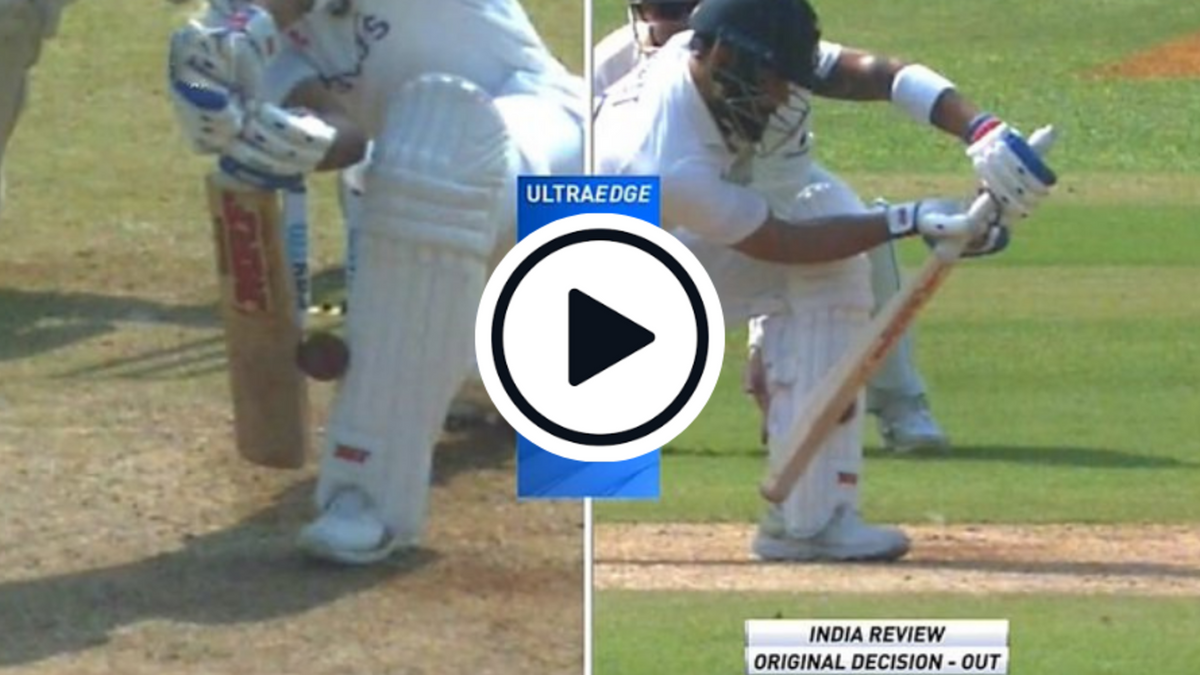
Watch: Virat Kohli’s return to the India side was marred by controversy as he was given lbw with a tight bat-pad decision going against him in the second Test against New Zealand.
Kohli, who opted for rest from the three T20Is and the first Test against New Zealand, did not have the best comeback as he was given out for a four-ball duck at the Wankhede Stadium in Mumbai on Friday, December 3. The last ball of the 30th over saw Ajaz Patel send down a fullish delivery, which the batter tried to push away by pressing forward, only for the ball strike him on the pads. Kohli was adjudged out lbw by umpire Anil Chaudury but immediately went up for a review.
Virender Sharma, the TV umpire asked for UltraEdge, which showed a spike when the ball was close to the bat. Further replays suggesting that the ball might have touched the bat and the pad simultaneously. “Ball and bat and pad appear to be together. I don’t have any conclusive evidence to overturn that,” stated Sharma, who asked Chaudhary to give Kohli out without looking at the ball tracking. Sharma asked for the ball tracking upon being reminded by Chaudhary, which showed three reds as Kohli walked back in disbelief.
Clause 36.2.2 of the MCC Laws of Cricket states that “if the ball makes contact with the striker’s person and bat simultaneously, this shall be considered as the ball having first touched the bat.”
The Laws of Cricket occasionally differ from the ICC playing conditions in subtle ways, and the same clause in the ICC’s rule book states, “if the bowler’s end umpire is not satisfied that the ball intercepted the batsman’s person before it touched the bat, the batsman shall be given not out.”
Sanjay Bangar, former India batting coach, disagreed with the decision, suggesting that there was a clear deviation before the ball hit the pad. Speaking on Star Sports during the lunch break, Bangar said, “I certainly felt the ball hit the bat first. You can see the deviation, where the ball was going after the impact. Clearly, the ball hit the bat first. Look at that deviation. Now, for the ball to come back and hit the pad, it is only because there is something on it. Otherwise, there was no chance that the ball would have come back so much and deviated. So, clearly an error on the part of the umpire.
“What happens is that if the third umpire looks to slow down the replay, it gets difficult for him. So, it’s rather a good thing for him to see the review in real-time, and then he could have seen the deviation. Slowing it down confuses the umpire in making the right decision.”
Bangar’s view was shared by former India batter Wasim Jaffer. “That was bat first in my opinion,” he tweed. “And I understand the ‘conclusive evidence’ part. But I think this was an instance where common sense should have prevailed. But as they say common sense is not so common. Feel for Virat Kohli.”
That was bat first in my opinion. And I understand the ‘conclusive evidence’ part. But I think this was an instance where common sense should have prevailed. But as they say common sense is not so common. Feel for Virat Kohli. #Unlucky #INDvNZ
— Wasim Jaffer (@WasimJaffer14) December 3, 2021
However, Simon Doull, a former New Zealand seamer and commentator for the series, disagreed. “Everyone in the commentary box thought it hit the pad first and then went back on the bat and then on the pad. So, the decision that Chaudhary made was out, therefore the third umpire has to find conclusive evidence to overturn the decision. The images clearly show the ball clipping on the pad first, then going on to the bat then the pad again. The umpires have both got it right. If you see the line of the ball, it can’t hit the bat first because the bat is behind the pad anyway. I think the umpires got it spot on.”








